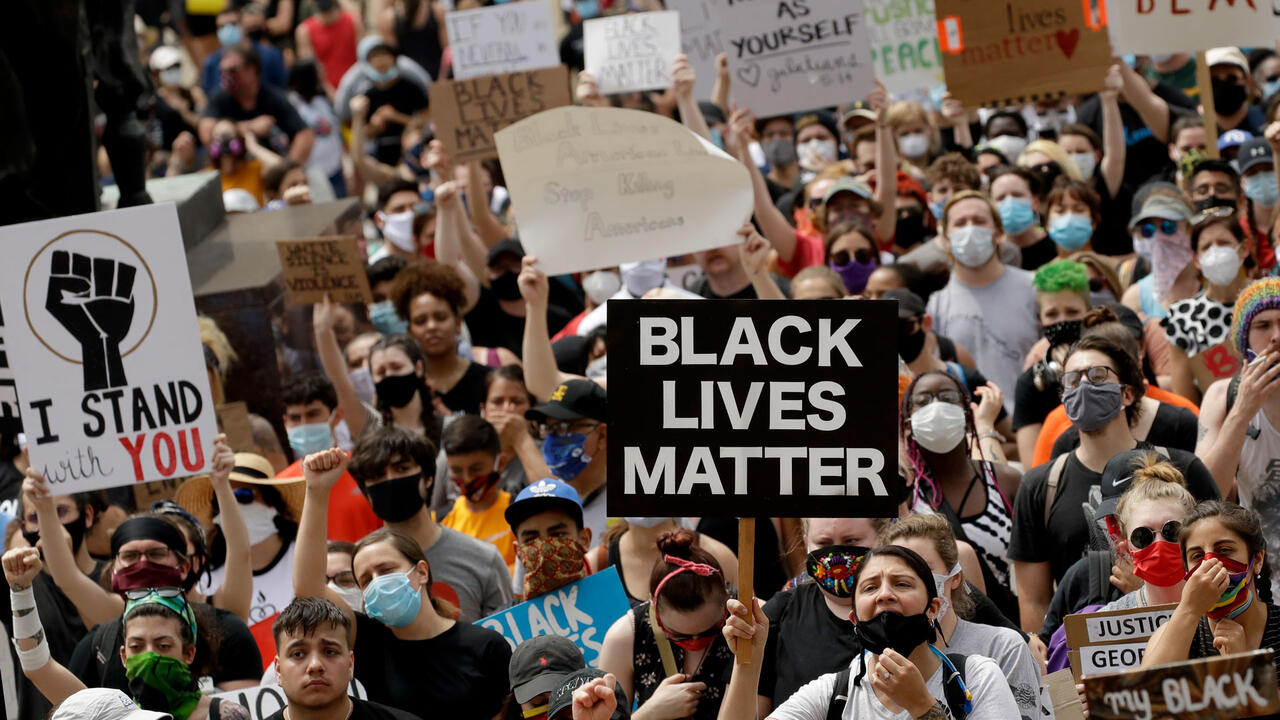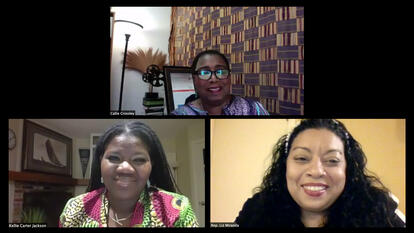BLM One Year Later: What Shifts in Support Mean for the Movement and Race Relations in 2021

Last summer, protesters took to the streets throughout the United States to protest police brutality in response to George Floyd’s death at the hands of Minneapolis police officers. These Black Lives Matter protests were some of the largest and most sustained in the country’s history. A year later, two Wellesley professors—Jennifer Chudy, Wellesley’s Knafel Assistant Professor of Social Sciences and an assistant professor of political science and Maneesh Arora, assistant professor of political science—have new findings about continued support for the BLM movement.
Chudy and her colleague Hakeem Jefferson, assistant professor of political science at Stanford University, wrote a piece for The New York Times about how their research showed that attitudes toward the movement—especially white attitudes—shifted from tacit support to outright opposition after the initial surge in support. And in The Washington Post’s Monkey Cage, Arora and his colleague LaGina Gause, assistant professor of political science at the University of California San Diego found that about 20 percent of protesters last summer weren’t necessarily supporting the BLM movement itself, but were instead probably expressing other grievances through the movement’s visibility.
We asked Chudy and Arora some questions about their research.
Were you surprised by your findings? Why or why not.
Arora: We were not surprised by our findings that many people who participated in the Black Lives Matter movement protests during the summer of 2020 were not deeply supportive of the movement or the movement’s goals. Our findings, combined with rapid decreases in support for the movement during the past year, make it clear that there is a disconnect between participating in the movement through attending a protest or posting positively about it on social media, and actual support for the goals of the Black Lives Matter movement.
We were also not surprised that grievances based on the COVID-19 pandemic helped drive protest attendance. Given the centrality of the pandemic to people’s lives and the broad belief that the government had failed in its response to the crisis, people needed an outlet to express those grievances.
“To the extent that white racial attitudes have moved over the last few years, any gains in racial sympathy may be offset by increased tolerance for racial hostility.”
Jennifer Chudy
Many social movements, particularly those that are “leaderful” and identity-based, make room for grievances that are not necessarily aligned with the goals of the social movement. Thus, the Black Lives Matter movement, an already established social movement that had captured media and public attention, provided an attractive outlet for people to express their various grievances.
Chudy: We were not too surprised. The surge in support for Black Lives Matter is interesting, but it reflects such an unusual moment in American politics that I wouldn’t read too much into it. Last summer, the country was under lockdown. With the ordinary distractions of life suspended, white Americans could turn their attention to police violence, an issue that is recurrent but often ignored. We also had a brutal and unambiguous video of Floyd’s death, which isn’t always the case. These atypical circumstances contributed to last summer’s polling.
Without this perfect storm, I doubt we’ll see these levels of white support in the future. This is for two reasons. First, research has demonstrated that racial attitudes are remarkably stable over time. Big events—like electing the first Black president or a once-in-a-lifetime (I hope!) public health crisis—may shift attitudes temporarily, but they often return to equilibrium. Second, to the extent that white racial attitudes have moved over the last few years, any gains in racial sympathy may be offset by increased tolerance for racial hostility. The latter attitude may also help us understand the backlash that Professor Jefferson and I note in the op-ed and discuss in our interview with NPR’s Code Switch.
What do your findings say about the state of race relations in America in 2021?
Arora: Our findings indicate that though the BLM protests of 2020 were arguably the largest and most diverse protests in the history of the U.S., not everyone who participated cares deeply about racial injustice or police brutality. Even those who express support for the movement do not necessarily agree with the larger policy or structural goals of the movement. Despite highly visible deaths of Black individuals at the hands of police, growing racial inequality in most areas of society, and consistent work in the Black Lives Matter movement and by other racial justice organizations and activists, racial prejudice and even a belief that racial inequality does not exist remain widespread.
Chudy: At the moment, we are witnessing the continuation of some long-standing trends, as well as the emergence of some unsettling patterns. For decades, public opinion on a range of policies, from domestic to foreign, has been deeply divided by race. By that I mean that we typically unearth a huge gap between what white people think about a given policy and what Black people think about that same policy. Other social categories—gender, religion, region—simply do not produce such stark differences between groups. In the 1990s, researchers called this racial divide “a divide without peer” in American public opinion, a title that is still appropriate today.
However, we are also witnessing some new developments. Political parties have become increasingly sorted by race, such that over the last few election cycles, fewer and fewer people of color identify as Republicans.
“Although movement participation may not be sustained, the presence of protesters whose goals are not aligned with BLM still mattered.”
Maneesh Arora
Party leaders must appeal to the demographics of their parties to win elections. As a consequence, we have a party system that is reinforcing the policy divide, further entrenching the role of race in our politics. The state of race relations in 2021 is therefore deeply partisan, which makes it especially politically intractable.
Is it important to maintain white support for the BLM movement? How does that happen? Does support typically fall when communities of color ask for concrete change?
Chudy: From my perspective, the most important thing is to create policy that mitigates racial inequality. Unlike individual behavior, government policy can direct substantial resources to addressing a social problem, shaping outcomes at a broad scale. Policy is also more enduring. To the extent that white support for BLM facilitates this type of policy, then yes, I think it is important to maintain support for the movement.
Arguably, the last time we saw major national legislation of this kind was during the 1960s with the Voting Rights Act and the Civil Rights Act. Here, the efforts of many actors contributed to the legislative success of these bills. Elite support—the president and members of Congress—was necessary for shepherding the legislation from inception to implementation. But active citizen engagement—on the streets and in the voting booths—was also crucial. This is because elites, who are often seeking reelection, have an incentive to respond to citizen grievances. Some of these citizens are white, but many others are not. So though it is important to assess white opinion, it is only one piece of the puzzle.
Why do large-scale protests like the ones from last summer draw people who attend for reasons other than the stated purpose of the protest? (Visibility? Community? Common outrage, even if not for a common cause?)
Arora: There are many reasons why an individual would choose to join a protest or participate in a social movement, including expressing their opposition to something they consider unjust or a desire to change circumstances in society. However, demand for protest is much more likely to turn into actual participation when protest opportunities exist that are “attractive” to the individual. Large protests like the ones we saw after the murders of George Floyd, Breonna Taylor, and others may have been an attractive protest opportunity because the movement structure was in place and flourishing and had captured the attention of the media and public. Leaderful movements such as BLM are especially attractive because they provide room for those whose protest goals do not necessarily align with the goals of the movement.
Although this means that movement participation may not be sustained, the presence of protesters whose goals are not aligned with BLM still mattered for several reasons. First, the size, diversity, and breadth of the movement helped produce important budgetary and policy changes at the state and local level throughout the country. Second, the geographic breadth of the protest may have influenced voting behavior, particularly given that it was an election year. Third, local coalitions of activists are being created in cities, suburbs, and small towns as a result of the protests, which may lead to more sustained social and racial justice work.


